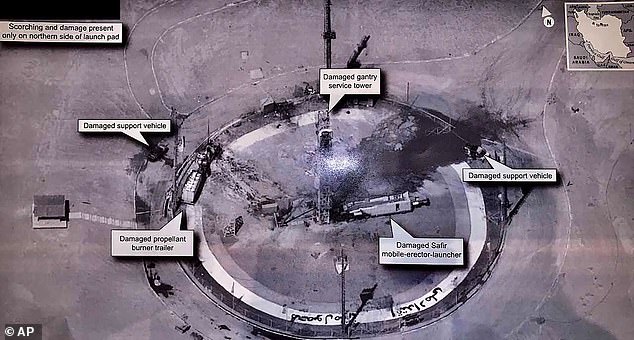
Amateur spy satellite trackers claim that they have pinpointed the source of the photograph tweeted last week by President Trump of an Iranian rocket site that suffered an explosion.
The photo, which caused controversy since it was believed to have been classified, was likely snapped by USA-224, a powerful spy satellite launched by the Pentagon’s National Reconnaissance Office in 2011.
The satellite’s capabilities are considered a closely guarded state secret, which is why Trump’s tweet raised eyebrows among national security experts who say that it may have given America’s adversaries too much information.
Astronomers such Dr. Marco Langbroek, Cees Bassa, and Purdue grad student Michael Thompson were able to use the photograph tweeted by Trump to glean key bits of data, according to National Public Radio.
Trump on Friday tweeted a picture showing the aftermath of an accident that is believed to have taken place during preparations for the launch of a Safir rocket at the Imam Khomeini Spaceport in Semnan, Iran.
Iran was reportedly preparing to send the Safir, which was equipped with a satellite of its own, into space.
But experts say that the rocket exploded during refueling.
Images of the aftermath of the accident were taken by commercial satellites, but the picture tweeted by Trump was noteworthy because of its extremely high resolution.
Langbroek says that he was able to determine the approximate time that the photograph was taken by observing the obliqueness of the circular launch pad.
Based on that information, Langbroek and others concluded that the image was most likely taken by USA-224.
They also were able to estimate the approximate time that the picture was taken by noticing the shadows cast by the towers at the site.
They then could approximately match the time that the picture was taken by researching which satellite was hovering over the area at that moment.
The experts realized that the trajectory of USA-224 put it in position to take the photo at the calculated time.
USA-224 is a reconnaissance satellite that was manufactured by Lockheed Martin.
‘It’s basically a very large telescope, not unlike the Hubble Space Telescope,’ Langbroek says.
‘But instead of looking up to the stars, it looks down to the earth’s surface and makes very detailed images.’
Thompson says that any amateur astronomer with a telescope in their backyard can look up at the sky and see satellites.
‘They’re super bright in the sky and are easy to find,’ he says.
Once a satellite is spotted in the sky, it is simple to track its future trajectory.
‘Using math to calculate an orbit is really easy,’ he says.

Thompson figured out that USA-224 flew over the Iranian space center just after the accident took place.
Both Thompson and Langbroek calculated that the satellite flew over the area at approximately 2:14pm local time.
Experts say that the high resolution of the image is a testament to how powerful the satellite’s telescope is.
Photographing the earth from orbit is difficult since the atmosphere and the satellite’s constant motion would make any image blurry.
After Trump tweeted the photograph, experts believe that other countries will try and obtain more information about the USA-224.
‘I imagine adversaries are going to take a look at this image and reverse-engineer it to figure out how the sensor itself works and what kind of post-production techniques they’re using,’ says Melissa Hanham, a satellite imagery expert at the Open Nuclear Network in Vienna, Austria.
























